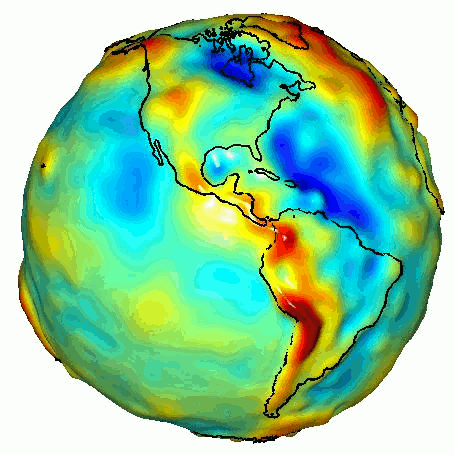You may have seen a lot of talk about a “gravity hole” in the Indian Ocean. It’s an easier-to-remember name for what scientists call the Indian Ocean Geoid Low (IOGL), and it’s a gravity anomaly that’s been puzzling scientists for a long time.
The Earth isn’t smooth. Just look at plunging depths like the Mariana Trench or the dizzying heights of Everest. These peaks and troughs in the planet’s surface mean that the mass of the Earth isn’t evenly distributed, and therefore, neither is the gravity.
Here’s a delicious blend of scientific and colloquial language to put it into context:
“The Earth is basically a lumpy potato,” were the wise words study co-author Attreyee Ghosh, a geophysicist and associate professor at the Indian Institute of Science, shared with CNN. “So technically it’s not a sphere, but what we call an ellipsoid, because as the planet rotates the middle part bulges outward.”
Gravity is a force that pulls objects towards a mass, and in areas of high gravity like Jupiter – the largest planet in the Solar System – it would be really hard for a human to jump up even a single step. Compare that to the Moon, where clearing 2.7 meters (9 feet) would be easy.

A map of the gravity gradients across Earth, where blue is low and red is high.
The gravity gradients across our planet aren’t so dramatic as on Jupiter and the Moon, but they are varied, which brings us back to the IOGL, a peculiar “gravity hole” out in the ocean. Here sits the lowest gravity found on the planet, with a dip in sea level of around 100 meters (328 feet). Since an increase in mass means higher gravity, it was figured that the gravity dip at the IOGL must be due to a lack of mass. The only puzzling thing being, we never worked out quite where it came from.
Now, Ghosh and colleague Debanjan Pal have run a series of computer models to study the Indian Ocean as it was over the last 140 million years. Doing so meant they could observe Earth as it was in its geological past, when the lumpy potato that is our planet was lumpy in different places.
A common theme among the 19 simulations in which the gravity hole formed was the presence of plumes of magma in the Earth’s mantle – a wedge of gloopy rock that fills the gap between the core and the crusty exterior. By modeling tectonic plate movement and global mantle convection, a leading hypothesis emerged.
When the Indian plate began drifting towards Asia a few hundred million years ago, the gap between the continents closed as an oceanic plate – called the Tethys plate – slipped under the Earth’s surface and into the mantle. As it did, it feasibly could have stirred up plumes, changing the density of magma sitting beneath the spot where the IOGL formed. And so, their theory goes, a mysterious gravitational anomaly was born.
It’s a fascinating hypothesis, but it’s not without its caveats. Predicting with absolute certainty what this lumpy potato we call Earth looked like that far back is near-impossible, given that the geological landscape is shaped by so many contributing factors. However, it’s an eye-opening insight into one of the most peculiar patches of the planet’s oceans.
Thought to have formed around 20 million years ago, the gravity hole in the Indian Ocean stretches across 3 million square kilometers (1.2 million square miles), creating a dramatic dip in sea level. It was first discovered by Felix Andries Vening Meinesz during a gravity survey back in 1948, and there have been many studies delving into its mysteries since, each one getting us a little closer to the exact origins of this bizarre Earthly phenomenon.
The study is published in Geophysical Research Letters.
Source Link: What's Up With This "Gravity Hole" In The Indian Ocean?